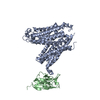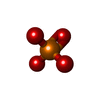+ Open data
Open data
- Basic information
Basic information
| Entry | Database: PDB / ID: 9j3m | |||||||||||||||||||||||||||
|---|---|---|---|---|---|---|---|---|---|---|---|---|---|---|---|---|---|---|---|---|---|---|---|---|---|---|---|---|
| Title | ADP/Pi bound Arabidopsis ATP/ADP translocator AtNTT1 | |||||||||||||||||||||||||||
 Components Components |
| |||||||||||||||||||||||||||
 Keywords Keywords | MEMBRANE PROTEIN | |||||||||||||||||||||||||||
| Function / homology |  Function and homology information Function and homology informationATP:ADP antiporter activity / chloroplast membrane / chloroplast envelope / plastid / mitochondrion / ATP binding Similarity search - Function | |||||||||||||||||||||||||||
| Biological species |   | |||||||||||||||||||||||||||
| Method | ELECTRON MICROSCOPY / single particle reconstruction / cryo EM / Resolution: 2.77 Å | |||||||||||||||||||||||||||
 Authors Authors | Lin, H.J. / Huang, J. / Li, T.M. / Li, W.J. / Su, N.N. / Zhang, J.R. / Wu, X.D. / Fan, M.R. | |||||||||||||||||||||||||||
| Funding support |  China, 1items China, 1items
| |||||||||||||||||||||||||||
 Citation Citation |  Journal: Nature / Year: 2025 Journal: Nature / Year: 2025Title: Structure and mechanism of the plastid/parasite ATP/ADP translocator. Authors: Huajian Lin / Jian Huang / Tianming Li / Wenjuan Li / Yutong Wu / Tianjiao Yang / Yuwei Nian / Xiang Lin / Jiangqin Wang / Ruiying Wang / Xiaohui Zhao / Nannan Su / Jinru Zhang / Xudong Wu / Minrui Fan /  Abstract: Adenosine triphosphate (ATP) is the principal energy currency of all living cells. Metabolically impaired obligate intracellular parasites, such as the human pathogens Chlamydia trachomatis and ...Adenosine triphosphate (ATP) is the principal energy currency of all living cells. Metabolically impaired obligate intracellular parasites, such as the human pathogens Chlamydia trachomatis and Rickettsia prowazekii, can acquire ATP from their host cells through a unique ATP/adenosine diphosphate (ADP) translocator, which mediates the import of ATP into and the export of ADP and phosphate out of the parasite cells, thus allowing the exploitation of the energy reserves of host cells (also known as energy parasitism). This type of ATP/ADP translocator also exists in the obligate intracellular endosymbionts of protists and the plastids of plants and algae and has been implicated to play an important role in endosymbiosis. The plastid/parasite type of ATP/ADP translocator is phylogenetically and functionally distinct from the mitochondrial ATP/ADP translocator, and its structure and transport mechanism are still unknown. Here we report the cryo-electron microscopy structures of two plastid/parasite types of ATP/ADP translocators in the apo and substrate-bound states. The ATP/ADP-binding pocket is located at the interface between the N and C domains of the translocator, and a conserved asparagine residue within the pocket is critical for substrate specificity. The translocator operates through a rocker-switch alternating access mechanism involving the relative rotation of the two domains as rigid bodies. Our results provide critical insights for understanding ATP translocation across membranes in energy parasitism and endosymbiosis and offer a structural basis for developing drugs against obligate intracellular parasites. | |||||||||||||||||||||||||||
| History |
|
- Structure visualization
Structure visualization
| Structure viewer | Molecule:  Molmil Molmil Jmol/JSmol Jmol/JSmol |
|---|
- Downloads & links
Downloads & links
- Download
Download
| PDBx/mmCIF format |  9j3m.cif.gz 9j3m.cif.gz | 133.7 KB | Display |  PDBx/mmCIF format PDBx/mmCIF format |
|---|---|---|---|---|
| PDB format |  pdb9j3m.ent.gz pdb9j3m.ent.gz | 98.6 KB | Display |  PDB format PDB format |
| PDBx/mmJSON format |  9j3m.json.gz 9j3m.json.gz | Tree view |  PDBx/mmJSON format PDBx/mmJSON format | |
| Others |  Other downloads Other downloads |
-Validation report
| Summary document |  9j3m_validation.pdf.gz 9j3m_validation.pdf.gz | 470.4 KB | Display |  wwPDB validaton report wwPDB validaton report |
|---|---|---|---|---|
| Full document |  9j3m_full_validation.pdf.gz 9j3m_full_validation.pdf.gz | 481 KB | Display | |
| Data in XML |  9j3m_validation.xml.gz 9j3m_validation.xml.gz | 13.8 KB | Display | |
| Data in CIF |  9j3m_validation.cif.gz 9j3m_validation.cif.gz | 21.3 KB | Display | |
| Arichive directory |  https://data.pdbj.org/pub/pdb/validation_reports/j3/9j3m https://data.pdbj.org/pub/pdb/validation_reports/j3/9j3m ftp://data.pdbj.org/pub/pdb/validation_reports/j3/9j3m ftp://data.pdbj.org/pub/pdb/validation_reports/j3/9j3m | HTTPS FTP |
-Related structure data
| Related structure data |  61119MC  9j3jC  9j3lC  9j3nC  9j3oC M: map data used to model this data C: citing same article ( |
|---|---|
| Similar structure data | Similarity search - Function & homology  F&H Search F&H Search |
- Links
Links
- Assembly
Assembly
| Deposited unit | 
|
|---|---|
| 1 |
|
- Components
Components
| #1: Protein | Mass: 66654.609 Da / Num. of mol.: 1 Source method: isolated from a genetically manipulated source Source: (gene. exp.)   Homo sapiens (human) / References: UniProt: Q39002 Homo sapiens (human) / References: UniProt: Q39002 |
|---|---|
| #2: Antibody | Mass: 13474.857 Da / Num. of mol.: 1 Source method: isolated from a genetically manipulated source Source: (gene. exp.)   |
| #3: Chemical | ChemComp-ADP / |
| #4: Chemical | ChemComp-PO4 / |
| Has ligand of interest | Y |
| Has protein modification | Y |
-Experimental details
-Experiment
| Experiment | Method: ELECTRON MICROSCOPY |
|---|---|
| EM experiment | Aggregation state: PARTICLE / 3D reconstruction method: single particle reconstruction |
- Sample preparation
Sample preparation
| Component | Name: ADP/Pi bound Arabidopsis ATP/ADP translocator AtNTT1 / Type: COMPLEX / Entity ID: #1-#2 / Source: MULTIPLE SOURCES |
|---|---|
| Source (natural) | Organism:  |
| Source (recombinant) | Organism:  Homo sapiens (human) Homo sapiens (human) |
| Buffer solution | pH: 7.4 |
| Specimen | Embedding applied: NO / Shadowing applied: NO / Staining applied: NO / Vitrification applied: YES |
| Vitrification | Cryogen name: NITROGEN |
- Electron microscopy imaging
Electron microscopy imaging
| Experimental equipment |  Model: Titan Krios / Image courtesy: FEI Company |
|---|---|
| Microscopy | Model: FEI TITAN KRIOS |
| Electron gun | Electron source:  FIELD EMISSION GUN / Accelerating voltage: 300 kV / Illumination mode: FLOOD BEAM FIELD EMISSION GUN / Accelerating voltage: 300 kV / Illumination mode: FLOOD BEAM |
| Electron lens | Mode: DIFFRACTION / Nominal magnification: 130000 X / Nominal defocus max: 1600 nm / Nominal defocus min: 800 nm |
| Image recording | Electron dose: 52 e/Å2 / Film or detector model: GATAN K3 (6k x 4k) |
- Processing
Processing
| EM software | Name: PHENIX / Category: model refinement | ||||||||||||||||||||||||
|---|---|---|---|---|---|---|---|---|---|---|---|---|---|---|---|---|---|---|---|---|---|---|---|---|---|
| CTF correction | Type: PHASE FLIPPING AND AMPLITUDE CORRECTION | ||||||||||||||||||||||||
| 3D reconstruction | Resolution: 2.77 Å / Resolution method: FSC 0.143 CUT-OFF / Num. of particles: 649675 / Symmetry type: POINT | ||||||||||||||||||||||||
| Refine LS restraints |
|
 Movie
Movie Controller
Controller







 PDBj
PDBj





